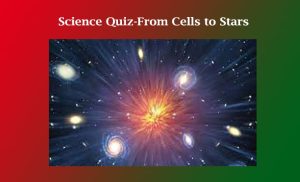Science Quiz-From Cells to Stars
Science Quiz-From Cells to Stars
Science Quiz-From Cells to Stars
Q: What is the largest planet in our solar system?
Ans: Jupiter
Q: What is the chemical symbol for gold?
Ans: Au
Q: What causes the tides on Earth?
Ans: Gravitational pull of the moon
Q: What is the powerhouse of the cell?
Ans: Mitochondria
Q: Who developed the theory of relativity?
Ans: Albert Einstein
Q: What is the process by which plants make their own food?
Ans: Photosynthesis
Q: What is the Earth’s outermost layer called?
Ans: Crust
Q: What does DNA stand for?
Ans: Deoxyribonucleic acid
Q: What is the closest star to Earth, besides the sun?
Ans: Proxima Centauri
Science Quiz-From Cells to Stars
Q: What is the unit of measurement for force?
Ans: Newton
Q: Which element has the chemical symbol Fe?
Ans: Iron
Q: What causes a rainbow to form?
Ans: Refraction and reflection of light in water droplets
Q: What is the smallest bone in the human body?
Ans: Stapes (in the ear)
Q: What is the chemical symbol for water?
Ans: H2O
Q: What is the process by which water changes from a liquid to a gas?
Ans: Evaporation
Q: What is the study of fossils called?
Ans: Paleontology
Q: What is the largest organ in the human body?
Ans: Skin
Q: What type of energy is stored in food?
Ans: Chemical energy
Q: What is the speed of light in a vacuum?
Ans: Approximately 299,792 kilometers per second
Science Quiz-From Cells to Stars
Q: What is the main gas found in the Earth’s atmosphere?
Ans: Nitrogen
Q: What is the closest galaxy to the Milky Way?
Ans: Andromeda Galaxy
Q: What is the Earth’s primary source of energy?
Ans: The Sun
Q: What is the chemical symbol for table salt?
Ans: NaCl
Q: What is the unit of electrical resistance?
Ans: Ohm
Q: What is the largest organ inside the human body?
Ans: Liver
Q: What is the study of the Earth’s atmosphere called?
Ans: Meteorology
Q: What is the densest planet in our solar system?
Ans: Earth
Q: What causes the sound of thunder?
Ans: Rapid expansion of air due to lightning
Q: What is the process of a liquid turning into a gas at the surface of the liquid called?
Ans: Evaporation
Science Quiz-From Cells to Stars
Q: What is the chemical symbol for oxygen?
Ans: O
Q: What type of energy is associated with motion?
Ans: Kinetic energy
Q: What is the name of the force that resists the motion of one surface moving past another?
Ans: Friction
Q: What is the study of the Earth’s physical structure and substance called?
Ans: Geology
Q: What is the largest known mammal?
Ans: Blue whale
Q: What is the chemical symbol for carbon?
Ans: C
Q: What is the hardest natural substance known?
Ans: Diamond
Q: What is the process by which plants lose water through their leaves?
Ans: Transpiration
Q: What is the closest planet to the Sun?
Ans: Mercury
Q: What is the study of the behavior and properties of matter called?
Ans: Chemistry
Q: What is the layer of the atmosphere where weather occurs?
Ans: Troposphere
Q: What causes the sky to appear blue?
Ans: Scattering of sunlight by the atmosphere
Q: What is the chemical symbol for iron?
Ans: Fe
Q: What is the process of a gas turning into a liquid called?
Ans: Condensation
Q: What is the name of the force that pulls objects towards each other?
Ans: Gravity
Q: What is the chemical symbol for helium?
Ans: He
Q: What is the center of an atom called?
Ans: Nucleus
Q: What is the study of earthquakes called?
Ans: Seismology
Q: What is the unit of electrical potential or electromotive force?
Ans: Volt
Q: What is the main greenhouse gas responsible for global warming?
Ans: Carbon dioxide
Q: What is the study of the universe beyond the Earth’s atmosphere called?
Ans: Astronomy
Q: What is the chemical symbol for silver?
Ans: Ag
Science Quiz-From Cells to Stars
Q: What is the study of the composition, structure, properties, and reactions of matter called?
Ans: Chemistry
Q: What is the unit of electrical current?
Ans: Ampere
Q: What is the process of a liquid turning into a solid called?
Ans: Freezing
Q: What is the chemical symbol for sodium?
Ans: Na
Q: What is the Earth’s innermost layer called?
Ans: Inner core
Q: What is the study of the human body called?
Ans: Anatomy
Q: What is the chemical symbol for lead?
Ans: Pb
Q: What is the process of plants making food using sunlight called?
Ans: Photosynthesis
Q: What is the study of the structure and function of the nervous system called?
Ans: Neuroscience
Q: What is the smallest unit of matter?
Ans: Atom
Q: What is the study of the origin and history of the Earth called?
Ans: Geology
Q: What is the chemical symbol for copper?
Ans: Cu
Q: What is the force that opposes the relative motion of two surfaces in contact?
Ans: Friction
Q: What is the process by which plants absorb water through their roots?
Ans: Osmosis
Q: What is the study of the properties and behavior of light called?
Ans: Optics
Q: What is the chemical symbol for potassium?
Ans: K
Q: What is the unit of measurement for frequency?
Ans: Hertz
Q: What is the process of a gas turning directly into a solid called?
Ans: Sublimation
Q: What is the study of the interaction between organisms and their environment called?
Ans: Ecology
Q: What is the chemical symbol for nitrogen?
Ans: N
Q: What is the force that holds the nucleus of an atom together?
Ans: Strong nuclear force
Q: What is the study of the internal and external structure of plants called?
Ans: Botany
Q: What is the unit of electrical capacitance?
Ans: Farad
Q: What is the process of a solid turning directly into a gas called?
Ans: Sublimation
Q: What is the chemical symbol for calcium?
Ans: Ca
Q: What is the layer of the atmosphere above the stratosphere?
Ans: Mesosphere
Q: What is the study of heredity and variation in organisms called?
Ans: Genetics
Q: What is the unit of measurement for luminous flux?
Ans: Lumen
Q: What is the process of a gas turning into a liquid called?
Ans: Condensation
Q: What is the study of the Earth’s magnetic field and its behavior called?
Ans: Geomagnetism
Q: What is the chemical symbol for hydrogen?
Ans: H
Q: What is the force that acts opposite to the direction of motion of an object moving through a fluid?
Ans: Drag force
Q: What is the process of the changing of a substance from a gas to a solid without passing through the liquid state called?
Ans: Deposition
Q: What is the study of the universe and its origins called?
Ans: Cosmology
Q: What is the chemical symbol for tin?
Ans: Sn
Q: What is the unit of measurement for electrical resistance?
Ans: Ohm
Q: What is the process of a solid turning into a liquid called?
Ans: Melting
Q: What is the study of the structure, composition, and classification of rocks called?
Ans: Petrology
Q: What is the chemical symbol for neon?
Ans: Ne
Science Quiz-From Cells to Stars
Q: What is the unit of measurement for the amount of substance?
Ans: Mole
Q: What is the process of a liquid turning into a gas below its boiling point called?
Ans: Evaporation
Q: What is the study of the behavior and properties of matter when subjected to high pressures and temperatures called?
Ans: High-pressure physics
Q: What is the chemical symbol for silver?
Ans: Ag
Q: What is the unit of measurement for the force of electric current?
Ans: Ampere
Q: What is the process of a gas turning directly into a solid called?
Ans: Sublimation
Q: What is the study of the Earth’s structure and the processes that shape it called?
Ans: Geomorphology
Q: What is the chemical symbol for mercury?
Ans: Hg
Q: What is the unit of measurement for the intensity of sound?
Ans: Decibel
Q: What is the process of the solidification of magma or lava called?
Ans: Crystallization
Q: What is the study of the electrical properties and phenomena associated with the flow of current?
Ans: Electrodynamics
Q: What is the chemical symbol for nickel?
Ans: Ni
Q: What is the force exerted by a fluid against a surface in contact with it?
Ans: Pressure
Q: What is the process of a gas turning directly into a solid called without becoming a liquid first?
Ans: Deposition
Q: What is the study of the interaction between matter and electromagnetic radiation?
Ans: Spectroscopy
Q: What is the chemical symbol for magnesium?
Ans: Mg
Q: What is the unit of measurement for electrical potential difference?
Ans: Volt
Q: What is the process of a solid turning directly into a gas without passing through the liquid state called?
Ans: Sublimation
Q: What is the study of the properties and behavior of matter at very low temperatures called?
Ans: Cryogenics
Q: What is the chemical symbol for sulfur?
Ans: S
Q: What is the unit of measurement for the amount of light emitted per unit time?
Ans: Candela
Q: What is the process of a liquid turning into a gas within the bulk of the liquid called?
Ans: Boiling
Q: What is the study of the behavior of matter at extremely high temperatures and densities?
Ans: High-energy physics
Science Quiz-From Cells to Stars
Q: What is the chemical symbol for cobalt?
Ans: Co
Q: What is the unit of measurement for the rate of change of electric charge in an electrical circuit?
Ans: Ampere
Q: What is the process of a gas turning into a liquid called?
Ans: Condensation
Q: What is the study of the physical and chemical changes in the Earth’s interior called?
Ans: Geophysics
Q: What is the chemical symbol for chromium?
Ans: Cr
Q: What is the unit of measurement for electrical power?
Ans: Watt
Q: What is the process of a solid turning into a liquid called?
Ans: Melting. 0 0 0.
Science Quiz-From Cells to Stars
You May Like:







